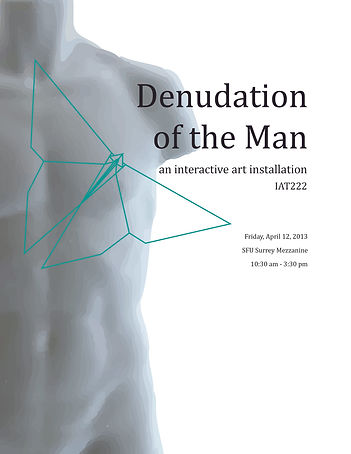INSTALLATION ART
Denudation of the Man
1)

2)
2) Denudation of the Man: Installation Video
1) Denudation of the Man: Poster
PROJECT BRIEF
This was an interactive installation art project conceptualized for a final school project. The project was completed by a team of six students where I acted as the team leader, conceptualizing, delegating and managing the team’s efforts and logistics.
The concept of this project is male gender stereotypes. It was inspired by an article by CTV news on gender stereotypes. The article mentioned that through conducting a survey on Canadians on gender equality, there was consensus that there is equality in the world. However, there was also a consensus that the sexes should not interchange roles in the workforce and within the family. Therefore, in this perceived equality there is still a difficulty to freely express oneself. Generally there is also a surplus of resources for females in regards to identity, equality and health than there is for males.
PROCESS
: Mannequin
A mannequin was chosen to represent a man for their generalized depiction of a man. This way, it would relieve the possibility of biasing the audiences’ judgment. This is because if a real model was used, the audience may unconsciously judge the model himself rather than the definition of a man.

THE INSTALLATION
The artwork comprised of a male mannequin adorned in origami butterflies patterned with an adjective and a QR code. Audience members would be invited to view the butterflies and dismantle any that they do not think describes a man. The QR codes led to a video of an actor portraying the adjective. Lastly, there were some blank butterflies for custom adjectives.
The goal of the artwork is to study the definition of a man. Therefore, the act of dismantling butterflies is reflective of the title; in which the audience is denuding the mannequin from the perceptions that a man cloaks himself with. The perceptions are represented by the butterflies. Therefore, to denude is to make the man vulnerable in order to study the definition of a man. Thus, whatever is left on the mannequin at the end of the installation will reflect the social standards that a man must wear to conform to society.

PROCESS
: Origami Butterflies
Origami butterflies were chosen to represent perceptions due to the fact that perceptions are a man-made creation, which is a shared attribute with the art of origami. The medium of paper that origami uses is also symbolic as it represents the rigidity and fragility of a man. Rigidity is seen through the compaction and geometrical shapes created when folded. Fragility is seen through the frailty of the medium itself. Lastly, the colour white of the paper and the colour grey for the font of the adjectives contains the connotations of respect and purity. The design and layout were done by me using Photoshop and Illustrator.
PROCESS
: QR Codes + Videos
It was noted that the interaction of this installation might be lacking and needed something more to increase the level of interaction and immersion.
Thus the idea of using QR codes was adapted. Scanning a QR code on the butterfly after removing it from the mannequin would lead to a video of an actor portraying the adjective; which increases the level of interaction. A male model was brought in to act out the adjectives with select clothing and make up to provide easy visualization of the adjective. All of the styling, makeup and directing were done by me whereas the filming and editing was done by my teammates.
The video clip featured the model acting out the adjective as humanely as possible with several cuts with a short intro sequence in the beginning. The ending of the video clip played a sound clip voiced by the actor stating “[the adjective] does not describe a man”, giving the participant a reflection of their decision. Over twenty video clips were produced for each adjective using After Effects.














PROCESS
: Result
First, people did not get the point of the installation art unless it was fully explained by a teammate, which in turn made them understand it better and commented on the uniqueness of the concept of the installation.
Second, the male participants provided more constructive input into the installation than the female participants, taking down adjectives without hesitation. There was one participant who took multiple butterflies off the mannequin, mostly words artistic connotations; which could have been seen as a snarky gesture or representative that a man should not be artistic.
Lastly, the QR code was seen as a unique part of the installation. Participants commented on its usefulness for visual reference. But many participants did not think to scan the QR codes unless prompted by our group members. It also seemed that many participants already had their own idea of what a man of the chosen adjective would look like.
In conclusion, as a team we feel that our installation was very successful. Many students participated and commented on how they thought the piece was intriguing and thought-provoking. We are proud of our achievement not only because we feel that participants were able to reflect on social stereotypes and roles, but also because we ourselves were able to explore in depth our own personal opinions on the matter.
Full documentation can be found here:















